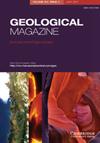Malformed individuals of the trilobite Estaingia bilobata from the Cambrian Emu Bay Shale and their palaeobiological implications
IF 2
3区 地球科学
Q3 GEOSCIENCES, MULTIDISCIPLINARY
引用次数: 3
Abstract
Abstract Malformed trilobite specimens present important insight into understanding how this extinct arthropod group recovered from developmental or moulting malfunctions, pathologies, and injuries. Previously documented examples of malformed trilobite specimens are often considered in isolation, with few studies reporting on multiple malformations in the same species. Here we report malformed specimens of the ellipsocephaloid trilobite Estaingia bilobata from the Emu Bay Shale Konservat-Lagerstätte (Cambrian Series 2, Stage 4) on Kangaroo Island, South Australia. Ten malformed specimens exhibiting injuries, pathologies, and a range of teratologies are documented. Furthermore, five examples of mangled exoskeletons are presented, indicative of predation on E. bilobata. Considering the position of malformed and normal specimens of E. bilobata in bivariate space, we demonstrate that the majority of malformed specimens cluster among the larger individuals. Such specimens may exemplify larger forms successfully escaping predation attempts, but could equally represent individuals exhibiting old injuries that were made during earlier (smaller) growth stages that have healed through subsequent moulting events. The available evidence from the Emu Bay Shale suggests that this small, extremely abundant trilobite likely played an important role in the structure of the local ecosystem, occupying a low trophic level and being preyed upon by multiple durophagous arthropods. Furthermore, the scarcity of malformed E. bilobata specimens demonstrates how rarely injuries, developmental malfunctions, and pathological infestations occurred within the species.寒武纪鸸鹋湾页岩三叶虫的畸形个体及其古生物学意义
摘要畸形三叶虫标本为了解这个已灭绝的节肢动物群体如何从发育或换羽故障、病理和损伤中恢复提供了重要的见解。以前记录的畸形三叶虫标本通常被单独考虑,很少有研究报告同一物种的多种畸形。在这里,我们报道了来自南澳大利亚袋鼠岛Emu湾页岩Konservat Lagerstätte(寒武纪系列2,第4阶段)的椭圆头三叶虫Estainia bilobata的畸形标本。记录了10个表现出损伤、病理和一系列畸形的畸形标本。此外,还介绍了五个外骨骼受损的例子,表明对毕氏E.bilobata的捕食。考虑到畸形和正常的毕氏E.bilobata标本在双变量空间中的位置,我们证明大多数畸形标本聚集在较大的个体中。这样的标本可能是成功逃脱捕食企图的较大形态的例子,但也可能代表表现出早期(较小)生长阶段所受旧伤的个体,这些旧伤已通过随后的换羽事件愈合。来自埃木湾页岩的现有证据表明,这种体积小、数量极为丰富的三叶虫可能在当地生态系统的结构中发挥了重要作用,处于低营养水平,并被多种硬食节肢动物捕食。此外,畸形毕氏杆菌标本的稀缺性表明,该物种很少发生损伤、发育障碍和病理性感染。
本文章由计算机程序翻译,如有差异,请以英文原文为准。
求助全文
约1分钟内获得全文
求助全文
来源期刊

Geological Magazine
地学-地球科学综合
CiteScore
4.70
自引率
0.00%
发文量
111
审稿时长
3 months
期刊介绍:
Geological Magazine, established in 1864, is one of the oldest and best-known periodicals in earth sciences. It publishes original scientific papers covering the complete spectrum of geological topics, with high quality illustrations. Its worldwide circulation and high production values, combined with Rapid Communications and Book Review sections keep the journal at the forefront of the field.
This journal is included in the Cambridge Journals open access initiative, Cambridge Open Option.
 求助内容:
求助内容: 应助结果提醒方式:
应助结果提醒方式:


